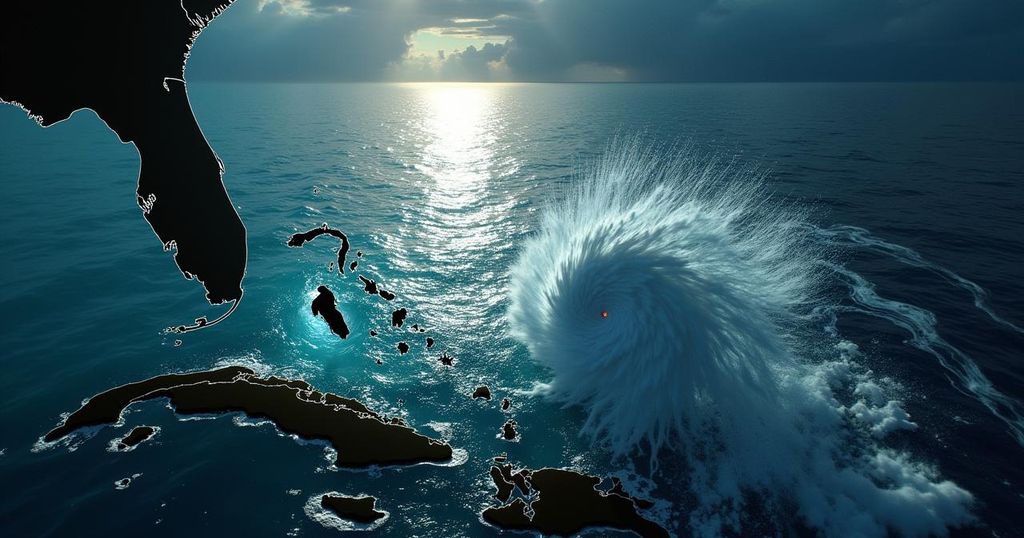Impending Impact of Hurricane Milton on Florida’s Gulf Coast

Hurricane Milton is approaching Florida as a category 4 hurricane, prompting state declarations of emergency and mass evacuations. With maximum winds near 155 mph, significant storm surges and rainfall are expected to cause life-threatening conditions. Milton’s rapid intensification and the presence of other hurricanes in the Atlantic raise concerns about climate trends and severe weather impacts.
As Hurricane Milton approaches Florida, the state is already grappling with emergency preparations following the earlier impact of Hurricane Helene. The governor’s office has declared a state of emergency for susceptible regions, and mass evacuations are currently in progress to ensure the safety of residents. The US National Hurricane Center (NHC) has indicated that “Milton has the potential to be one of the most destructive hurricanes on record for west-central Florida,” signaling serious concerns among officials and residents alike. With maximum sustained winds reaching nearly 155 mph (250 km/h), Milton is classified as a powerful category 4 hurricane on the Saffir-Simpson Hurricane Wind Scale, although it has briefly achieved category 5 status. The NHC report highlights the likelihood of fluctuations in intensity; however, it is expected that Milton will remain extraordinarily dangerous right through its landfall. The rapid intensification of Milton, noted as the third most rapid in the Atlantic basin, has raised alarm bells. The Gulf of Mexico’s elevated ocean heat contributes significantly to Milton’s intensity, as warmer sea surface temperatures supply the energy hurricanes require to grow stronger. Characteristically, Milton is a large hurricane, with hurricane-force winds extending up to 30 miles (45 km) from its center and tropical-storm-force winds stretching up to 80 miles (130 km). An extensive storm surge is also predicted along the Gulf coast of Florida, which poses an immensely threatening situation for coastal communities. In Mexico, areas along the northern coast of the Yucatan Peninsula are expected to experience a storm surge raising water levels by 4 to 6 feet (1.2 – 1.8 m) above ground. Coastal regions in the Tampa Bay area may see flooding due to surges of 10 to 15 feet (3 to 4.5 meters). Furthermore, significant rainfall ranging between 5 to 10 inches (12.7 to 25.4 cm) is anticipated, with localized areas potentially receiving upwards of 15 inches, raising concerns about flash flooding, urban flooding, and adverse river conditions. Hurricane Milton is projected to make landfall in Florida, following a similar trajectory as Hurricane Helene but differing in precise location, hitting near Fort Myers, where Hurricane Ian struck in 2022. After making landfall, Milton is expected to traverse the state and re-enter the Atlantic Ocean. In addition to Milton, two other hurricanes, Leslie and Kirk, are concurrently active in the Atlantic. Kirk, currently a category 1 hurricane, is anticipated to weaken as it reaches Europe, with forecasts indicating significant impact due to wind and rainfall in France, particularly in the Loire and Lorraine regions including the Paris area.
The phenomenon of hurricanes becoming increasingly severe has captured global attention, with recent events such as Milton and Helene being termed “historic,” “catastrophic,” and “unprecedented.” The link between ocean temperatures and hurricane intensity has intensified discussions about climate extremes, especially in the context of the Gulf of Mexico, which has been noted for its exceptionally warm waters, further aiding hurricane strength. This year, the unusual occurrence of multiple hurricanes concurrently active in October is significant, sparking further scrutiny and concern among meteorologists and coastal communities.
In conclusion, Hurricane Milton is poised to significantly affect Florida and parts of the Gulf region, highlighting the increasing dangers associated with hurricanes as they rapidly intensify. Emergency services and residents are urged to take precautions as the storm draws near, with the potential for catastrophic flooding and destructive storm surges. The concurrent activity of multiple hurricanes emphasizes the urgent need for preparedness and awareness in hurricane-prone areas.
Original Source: wmo.int






